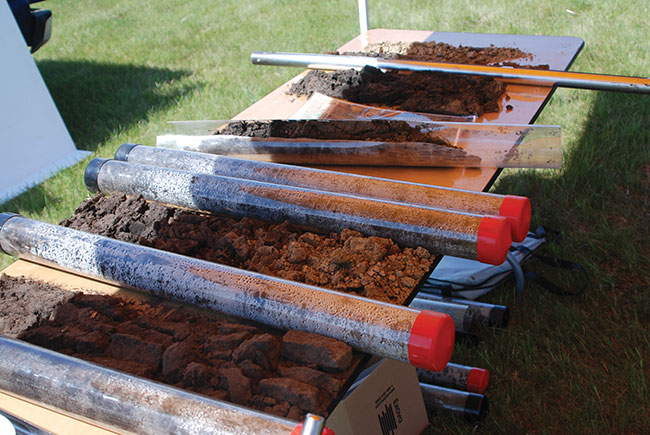
Features
Soil
Alberta Soil Health Benchmark project underway
Project to assist in assessing, interpreting and understanding soil health status and management responses in Alberta.
April 3, 2024 By Bruce Barker
 Alberta Soil Health Benchmark project is developing a way to measure and improve soil health.
Photo by Bruce Barker.
Alberta Soil Health Benchmark project is developing a way to measure and improve soil health.
Photo by Bruce Barker. Soil health is at the foundation of sustainable agricultural production. Yet, despite the importance of soil health to farmers and consumers, few methods exist to measure soil health or to establish a baseline for measuring improvement or degradation of soil health on a regional basis. A research project in Alberta is working to develop a better understanding of soil health and create a provincial database of physical, biological and chemical soil health indicators.
“The project was developed because there was a lack of information on soil physical and biological functionality. To assess the soil health status, physical and biological indicators need to be measured along with soil chemical (fertility) properties. Soil fertility had been the primary focus for soil evaluations in the past,” says Dr. Yamily Zavala, soil health and crop management specialist with Chinook Applied Research Association (CARA) – Oyen, Alta. “Soil biology plays a crucial role in improving soil health and healing the soil. The process is not well understood. However, even though the role in improving soil physical and chemical functionality has been well documented.”
Zavala says the evaluation of biological soil characteristics has been available but only used as a tool for soil health during the past few years in laboratories in the United States and more recently in eastern Canada. Existing biological and physical tests have not been evaluated and monitored specifically for Alberta soils. To fill in that gap, CARA led a five-year Soil Health Benchmark evaluation project in Alberta from 2018 to 2022. The study was funded by the Canada Agriculture Partnership (CAP) program.
The objectives of this study included: 1) evaluating soil health indicators, focusing not only on the chemical (complete soil fertility) soil properties but also on soil physical and biological constraints, and 2) creating a soil health benchmark database to develop provincial and regional Scoring Functions for assessing, interpreting, monitoring and understanding soil health status and management responses.
Twenty soil samples for a minimum of 220 sites per year were collected by 11 of Alberta’s 12 Applied Research and Forage Associations (ARAs). At each location, a composite soil sample (six to eight cores) was collected using a two-inch diametre pipe sleeve. The depth of the sampling was based on the compaction layer found during the infield sampling measurements. If the 300 PSI compaction layer was within the top six inches of the soil, samples for that site were collected at two depths of zero to three inches and three to six inches. Otherwise, samples were collected at a zero- to six-inch depth.
At the CARA soil health lab (CARASHLab), samples were analyzed for biological and physical properties. Biological evaluations included active carbon, soil microbial respiration, total fungal and bacterial biomass, nematode and protozoa functional groups as part of the Soil Food Web. Physical properties were measured both in the field (soil compaction and water infiltration) and at CARASHLab (soil texture and wet aggregate stability). Chemical/soil fertility measurements like macro and micronutrients, pH, EC, cation exchange capacity and organic matter were analyzed by a commercial lab. Total carbon, organic carbon and total nitrogen were evaluated at the University of Alberta.
“Understanding the role of biology and physical soil parameters is linked to an increasing interest in soil health, plant health and ultimately food quality. There is also concern with carbon both in the air and the soil. Since carbon and soil health are very closely connected, management practices improving soil health to regenerate the agricultural system will also improve carbon sequestration,” explains Zavala.
Soil Health reports were initially generated using the Cornell Comprehensive Assessment of Soil Health (CASH) framework. Statistical analysis was used for the Soil Management Assessment Framework (SMAF/CASH) to develop preliminary scoring functions for the Alberta Soil Health Benchmark.
“Alberta’s Soil Health Framework Tool uses these Score Functions to assess and monitor soil health constraints and to adjust soil health changes resulting from applied targeting managements,” says Zavala.
Data generated for each site sampled has been assembled into Soil Health Benchmark (SHBenchmark) comprehensive reports. The reports capture a picture of the soil health status and serve as a point of reference for comparison to future monitoring and management changes. Soil scoring curves provide an indication of whether the measurement is an area of concern or constraint for overall soil productivity. Suggestions for mitigation or improvement of soil-specific conditions are also provided.
Zavala says the soil health benchmark report is like a scorecard of baseline information that can be compared to future soil assessments and to monitor progress toward changing soil health constraints. She says Dr. Derek Mackensie at the University of Alberta has approached her to find a way for the Alberta Soil Health Benchmark information to be used in the development of an App for soil health assessments.
“Understanding soil health will give Alberta producers a valuable tool for making strategic management decisions on their farms and ranches,” says Zavala. “Our lab is unique, and we are calling it The Farmers’ Lab. Anyone can come and even assess their soils and plant samples with us. Another reason why it is a Farmers’ Lab is that over 80 per cent of the initial lab instruments and materials were purchased or acquired by donations from producers and industry.”